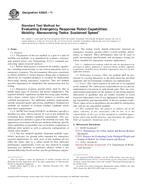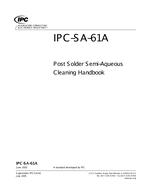
ASTM E2829 PDF
Original price was: $48.00.$29.00Current price is: $29.00.
Standard Test Method for Evaluating Emergency Response Robot Capabilities: Mobility: Maneuvering Tasks: Sustained Speed
| Published by | Publication Date | Number of Pages |
| ASTM | 07/01/2011 | 9 |
ASTM E2829 – Standard Test Method for Evaluating Emergency Response Robot Capabilities: Mobility: Maneuvering Tasks: Sustained Speed
1.1 Purpose:
1.1.1 The purpose of this test method, as a part of a suite of mobility test methods, is to quantitatively evaluate a teleoperated ground robot's (see Terminology E2521) sustained maneuvering speed on paved surfaces.
1.1.2 Robots shall possess a certain set of mobility capabilities, including maneuvering, to suit critical operations such as emergency responses. The environments often pose constraints to robotic mobility to various degrees. Being able to maneuver effectively for extended distances is essential for deployment down-range during emergency responses. This test method specifies apparatuses to standardize this maneuvering task for testing.
1.1.3 Emergency response ground robots shall be able to handle many types of obstacles and terrain complexities. The required mobility capabilities include traversing gaps, hurdles, stairs, slopes, various types of floor surfaces or terrains, and confined passageways. Yet additional mobility requirements include sustained speeds and towing capabilities. Standard test methods are required to evaluate whether candidate robots meet these requirements.
1.1.4 ASTM Task Group E54.08.01 on Robotics specifies a mobility test suite, which consists of a set of test methods for evaluating these mobility capability requirements. This sustained speed test method is a part of the mobility test suite. The apparatuses associated with the test methods challenge specific robot capabilities in repeatable ways to facilitate comparison of different robot models as well as particular configurations of similar robot models.
1.1.5 The test methods quantify elemental mobility capabilities necessary for ground robot intended for emergency response applications. As such, users of this standard can use either the entire suite or a subset based on their particular performance requirements. Users are also allowed to weight particular test methods or particular metrics within a test method differently based on their specific performance requirements. The testing results should collectively represent an emergency response ground robot's overall mobility performance as required. These performance data can be used to guide procurement specifications and acceptance testing for robots intended for emergency response applications.
Note 1 – Additional test methods within the suite are anticipated to be developed to address additional or advanced robotic mobility capability requirements, including newly identified requirements and even for new application domains.
1.2 Performing Location – This test method shall be performed in a testing laboratory or the field where the specified apparatus and environmental conditions are implemented.
1.3 Units – The values stated in SI units are to be regarded as the standard. The values given in parentheses are not precise mathematical conversions to inch-pound units. They are close approximate equivalents for the purpose of specifying material dimensions or quantities that are readily available to avoid excessive fabrication costs of test apparatuses while maintaining repeatability and reproducibility of the test method results. These values given in parentheses are provided for information only and are not considered standard.
1.4 This standard does not purport to address all of the safety concerns, if any, associated with its use. It is the responsibility of the user of this standard to establish appropriate safety and health practices and determine the applicability of regulatory limitations prior to use.
Product Details
- Published:
- 07/01/2011
- Number of Pages:
- 9
- File Size:
- 1 file , 400 KB
- Note:
- This product is unavailable in Russia, Ukraine, Belarus




